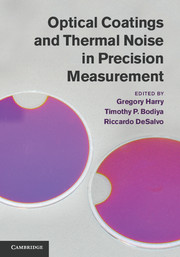Book contents
- Frontmatter
- Contents
- List of contributors
- Foreword
- Preface
- 1 Theory of thermal noise in optical mirrors
- 2 Coating technology
- 3 Compendium of thermal noises in optical mirrors
- 4 Coating thermal noise
- 5 Direct measurements of coating thermal noise
- 6 Methods of improving thermal noise
- 7 Substrate thermal noise
- 8 Cryogenics
- 9 Thermo-optic noise
- 10 Absorption and thermal issues
- 11 Optical scatter
- 12 Reflectivity and thickness optimization
- 13 Beam shaping
- 14 Gravitational wave detection
- 15 High-precision laser stabilization via optical cavities
- 16 Quantum optomechanics
- 17 Cavity quantum electrodynamics
- References
9 - Thermo-optic noise
Published online by Cambridge University Press: 05 January 2012
- Frontmatter
- Contents
- List of contributors
- Foreword
- Preface
- 1 Theory of thermal noise in optical mirrors
- 2 Coating technology
- 3 Compendium of thermal noises in optical mirrors
- 4 Coating thermal noise
- 5 Direct measurements of coating thermal noise
- 6 Methods of improving thermal noise
- 7 Substrate thermal noise
- 8 Cryogenics
- 9 Thermo-optic noise
- 10 Absorption and thermal issues
- 11 Optical scatter
- 12 Reflectivity and thickness optimization
- 13 Beam shaping
- 14 Gravitational wave detection
- 15 High-precision laser stabilization via optical cavities
- 16 Quantum optomechanics
- 17 Cavity quantum electrodynamics
- References
Summary
Introduction
The dielectric coatings typically used in high precision optical measurement consist of alternating layers of materials with different refractive indices (see Figure 9.1). For highreflectivity, the coating layers form pairs of high and low refractive index materials, referred to as doublets, with each component layer a quarter wave thick. In most cases, it is safe to assume that the coating reflects incident light from a mirror surface; a conceptually perfect plane at the boundary between the coating and the vacuum. However, a more precise picture is that of a reflection from each interface between coating layers, all of which add at the mirror surface to form the total reflected wave.
The displacement of the mirror surface, as interferometrically measured with the reflected wave, is given by the simple relation Δz = Δϕλ/4π, where Δϕ is the change in reflection phase of a field with wavelength λ, and Δz is the apparent change in position of the surface. In this chapter we will consider thermo-optic noise, which manifests itself as a change in the reflection phase of the coating resulting from thermal fluctuations in the coating materials.
How to change the reflection phase of a coating
The thermoelastic mechanism
Thermal expansion of the coating materials causes the thickness of a coating to change as a function of temperature. These temperature changes can be driven, or can result from statistical fluctuations in the coating material.
- Type
- Chapter
- Information
- Optical Coatings and Thermal Noise in Precision Measurement , pp. 129 - 144Publisher: Cambridge University PressPrint publication year: 2012

